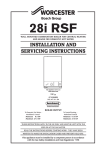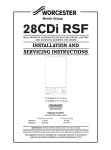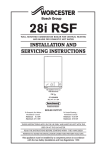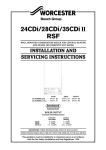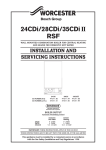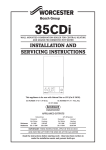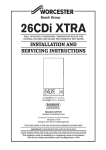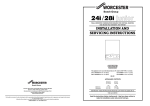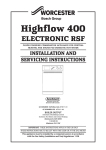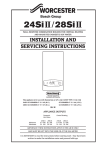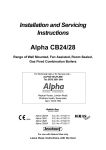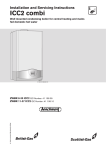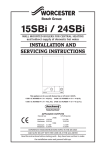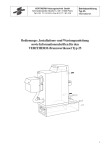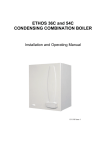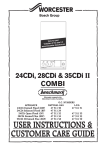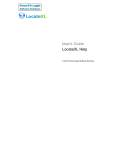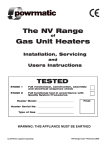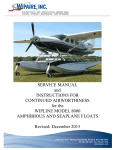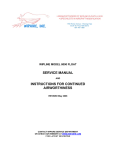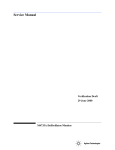Download Bosch Appliances 24I RSF Boiler User Manual
Transcript
Bosch Group 24i RSF WALL MOUNTED COMBINATION BOILER FOR CENTRAL HEATING AND MAINS FED DOMESTIC HOT WATER INSTALLATION AND SERVICING INSTRUCTIONS GC NUMBERS N.G. 47 311 37 L.P.G. 47 311 38 BOILER OUTPUT To Domestic Hot Water – Modulated Control Minimum 7.5 kW (25,600 Btu/h) Maximum 23.4 kW (80,000 Btu/h) To Central Heating – Modulated Control\ Auto Range Rated Minimum 7.5 kW (25,600 Btu/h) Maximum 23.4 kW (80,000 Btu/h) THESE INSTRUCTIONS APPLY IN THE UK ONLY THESE INSTRUCTIONS ARE TO BE LEFT WITH THE USER OR AT THE GAS METER This appliance must be installed by a competent person in accordance with the Gas Safety (Installation and Use) Regulations 1994 Contents 1. Installation Requirements . . . . . . . . . . . . . . . . . . . . . . . . . Page 2 2. General Information . . . . . . . . . . . . . . . . . . . . . . . . . . . . . . Page 2 3. Data Tables . . . . . . . . . . . . . . . . . . . . . . . . . . . . . . . . . . . . . . Page 4 4. Siting the Appliance . . . . . . . . . . . . . . . . . . . . . . . . . . . . . . Page 5 5. Siting the Flue. . . . . . . . . . . . . . . . . . . . . . . . . . . . . . . . . . . . Page 6 6. Air Supply . . . . . . . . . . . . . . . . . . . . . . . . . . . . . . . . . . . . . . . Page 6 7. Sealed System . . . . . . . . . . . . . . . . . . . . . . . . . . . . . . . . . . . Page 7 8. Open Vent System . . . . . . . . . . . . . . . . . . . . . . . . . . . . . . . . Page 7 9. Hot Water Supply . . . . . . . . . . . . . . . . . . . . . . . . . . . . . . . . Page 8 ......................................................... 10. Electrical . . . . . . . . . . . . . . . . . . . . . . . . . . . . . . . . . . . . . . . Page 9 11. Installing the Appliance . . . . . . . . . . . . . . . . . . . . . . . . . . Page 11 12. Commissioning the Appliance . . . . . . . . . . . . . . . . . . . . Page 16 13. Instructions to the User . . . . . . . . . . . . . . . . . . . . . . . . . . Page 18 14. Inspection and Service. . . . . . . . . . . . . . . . . . . . . . . . . . . Page 18 15. Replacement of Parts . . . . . . . . . . . . . . . . . . . . . . . . . . . . Page 20 16. Conversion Instructions . . . . . . . . . . . . . . . . . . . . . . . . . . Page 23 17. Operational Flow Diagrams. . . . . . . . . . . . . . . . . . . . . . . Page 24 18. Fault Finding . . . . . . . . . . . . . . . . . . . . . . . . . . . . . . . . . . . Page 26 19. Component Parts List. . . . . . . . . . . . . . . . . . . . . . . . . . . . Page 34 1. Installation Regulations 2. General Information 1.1 Gas Safety (Installation and Use) Regulations, October 1994 all gas appliances must be installed by a competent person in accordance with the above regulations. Failure to install appliances correctly could lead to prosecution. 1.2 The manufacturers notes must not be taken, in any way, as overriding statutory obligations. 1.3 The compliance with a British Standard does not, of itself, confer immunity from legal obligations. In particular the installation of this appliance must be in accordance with the relevant requirements of the following; Gas Safety (Installation and Use) Regulations 1994 as amended. Current IEE Wiring Regulations BS 7671. Local Building Regulations. Building Standards (Scotland)(Consolidation). Bylaws of the local Water Company. Health and Safety Document No. 635 (Electricity at Work Regulations). The British Gas Material and Installation Specification for central heating and hot water It should be in accordance with the relevant recommendations of the following British Standards. BS6798:1987 Specification for installation of gas fired hot water boilers of rated input not exceeding 60 kW. BS5449:1990 Central Heating for Domestic Premises. BS5546:1990 Installation of gas hot water supplies for domestic purposes. BS5440:1:1990 Flues and Ventilation for gas appliances of rated input not exceeding 60 kW: Flues. BS5440:2:1989 Flues and Ventilation for gas appliances of rated input not exceeding 60kW: Air Supply. BS6891:1988 Installation of low pressure gas pipework installations up to 28mm (R1). BS7593:1993 Central Heating system cleansing and flushing. BS5482:PART 1 Domestic Butane and Propane gas burning installations in permanent dwellings. 1.4 To ensure that the installation will perform to the highest standards, the system and components should conform to any other relevant British Standards in addition to those mentioned in the instructions. 1.5 The appliance complies with the Essential Requirements of the Gas Appliance Directive and other Directives currently applicable. 1.6 This appliance contains no asbestos products. There is no potential hazard due to the appliance being electrically unsafe. There are no substances used that are a potential hazard in relation to the COSHH Regulations 1988. 1.7 The advice and instructions given in this document covers, as far as possible, the foreseeable situations which may arise. Contact Worcester Heat Systems Technical Helpline for advice on specific installations. 2.1 This appliance is not suitable for external installation. 2.2 The appliance controls are set to provide a maximum output of 23.4 kW for the domestic hot water and central heating load. 2.3 The control circuit provides direct burner ignition. A pilot is not used. 2.4 PRINCIPAL APPLIANCE COMPONENTS. See Fig. 1. A low thermal capacity Gas to Water heat exchanger incorporating an integral Hot Water heat exchanger to provide domestic hot water. Fully modulating controls in the central heating and domestic hot water modes of operation. An expansion vessel, pressure gauge and pressure relief valve. A fixed by-pass for the central heating system. A Temperature safety cut-out control. A water flow regulator. A standard telescopic horizontal flue assembly giving flue lengths from 127mm to 350mm. Optional extra extension flue kits to provide for flue lengths up to 2500mm. An optional vertical flue kit to provide for flue lengths up to 3000mm including vertical flue terminal. Optional facia mounted mechanical programmer. Fig. 1. Water flow diagram. Bi-thermal gas to water heat exchanger Automatic air vent Sealed system expansion vessel Domestic water flow switch Circulating pump Pressure relief valve Fixed by-pass Safety discharge 2 Domestic hot water out Domestic C.H. C.H. cold flow return supply 2.5 ELECTRICAL SUPPLY Mains supply: 230V ~, 50 Hz, 180 watts. External fuse: 3A., Internal fuses: 2AT HRC(F1), and 1 AF (F2). 2.6 GAS SUPPLY The boiler requires 2.76 m3/h (97.5 ft3/hr) of natural gas with a calorific value of 37.78 MJ/m3 (1014 Btu/ft3) or 1.07 m3/h (37.8 ft3/hr) of propane with a calorific value of 95.65 MJ/m3 (2568 Btu/ft3). The meter governor should deliver a dynamic pressure of 20 mbar (8in w.g.) at the appliance, equivalent to a pressure of about 19-19.5 mbar at the gas valve on natural gas or 37.0 mbar (14.8in w.g.) at the appliance for propane. The gas meter and supply pipes must be capable of supplying this quantity of gas in addition to the demand from any other appliances being served. The table below gives an indication of limiting gas pipe lengths and the allowance to be made for fittings. Refer to BS6891 for further information. The complete installation, including the gas meter, must be tested for soundness and purged. Refer to BS 6891. Gas Discharge Rate Gas Discharge Rate 3 (m /hr) (m3/hr) Total length of gas supply pipe (metres) 3 6 9 12 Propane 1.5 – – – 8.0 5.2 4.2 3.6 15.9 8.8 8.5 7.2 Natural Gas 8.7 5.8 4.6 – 18.0 12.0 9.4 – 2.11 SYSTEM NOTES IMPORTANT Check that no dirt is left in either the gas or water pipework as this could cause damage to the appliance. The heating system should be flushed and treated in accordance with the recommendations of BS 7593:1992. Thoroughly flush cold water mains supply and purge the gas supply before finally connecting the appliance. The water pipe connections throughout a sealed system must be capable of sustaining a pressure of up to 3 bar. Radiator valves must conform to the requirements of BS 2767:1991. The relief valve discharge must be directed away from any electrical components or where it would cause a hazard to the user. A drain cock to BS 2879 must be fitted to the lowest point of the system. For circuit design purposes it is important that due note is taken of the information given in Table 3, section 3 relating to the available pump head. 2.12 SHOWERS, BIDETS, TAPS AND MIXING VALVES Hot and cold taps and mixing valves used in the system must be suitable for operating at mains pressure. Thermostatically controlled shower valves will guard against the flow of water at too high a temperature. Hot and cold mains fed water can be supplied direct to an overrim flushing bidet subject to local Water Company requirements. With all mains fed systems the flow of water from the individual taps will vary with the number of outlets operated simultaneously and the cold water mains supply pressure to the property. Flow balancing using “Ball-o-Fix” type valves is recommended to avoid an excessive reduction in flow to individual outlets. 2.13 SAFETY CONSIDERATIONS The appliance must not be operated in a waterless condition. The appliance must not be operated with the boiler inner casing cover removed. Work must not be carried out on the appliance without the gas and electricity supplies being switched off. Checks must be made to ensure that the ventilation openings made into walls and partitions are unobstructed and the correct size. 2.14 OPERATION Domestic Hot Water: With a demand for hot water the burner will light at its maximum setting and then automatically adjust its output to maintain the temperature of the delivered water. When hot water is no longer required, the burner will extinguish. The fan and pump may continue to run for a short period to dissipate the residual heat from the appliance. Central Heating: With a demand for heating the burner will light at its minimum setting and gradually increase to give a controlled temperature rise. When the required heating temperature is achieved the output of the appliance is then automatically adjusted to maintain the temperature of the system. The output can reduce down to a minimum of 7.5 kW. If the system no longer requires even the minimum output to maintain the desired room temperature the burner will extinguish. The fan and pump may continue to run to dissipate the residual heat from the appliance. The appliance will remain off for a fixed period before re-lighting to automatically meet the system requirements. Domestic Hot Water and Central Heating: The appliance will supply heat to the central heating system as required. A demand for domestic hot water at a tap or shower will override the central heating requirement for the period of the domestic hot water demand. When hot water is no longer required the appliance will return to the central heating state and its normal mode of operation. The fan may continue to run to dissipate the residual heat from the appliance as necessary. 2.15 DOMESTIC SUPPLY Devices capable of preventing the flow of expansion water must not be fitted unless separate arrangements have been made. Pipe size (Ømm) 15 22 28 22 28 Note: Each fitting used in the gas line from the meter is equivalent to a length of straight pipe which must be added to the straight pipe length to give the total length. i.e.: Bend = 0.5 metres, Tee = 0.5 metres, 90° Bend = 0.3 metres. 2.7 PACKING The appliance and flue components are packaged separately. 2.8 GENERAL INSTALLATION The appliance is for connection to a sealed system only. The specified ventilation openings made into a wall or compartment door must not be obstructed. If the appliance is to be fitted into a compartment then the compartment must conform to the requirements of BS 6798: 1987: Section 7. Do not place anything on top of the appliance. The clearances specified for servicing must be maintained. 2.9 FLUE The appliance has a multi-directional fanned flue system. The standard telescopic flue assembly length is from 127mm to 350mm. Extension flue lengths available are from 350mm to 2500mm. An optional vertical flue kit to provide for flue lengths up to 3000mm including vertical flue terminal. A terminal guard, Type K2, GC 393 553, is available from Tower Flue Components, Vale Rise, Tonbridge, TN9 1TB. Do not allow the flue terminal fitted to the outside wall to become obstructed or damaged. A kit for internal fixing of the flue is available separately. 2.10 CONTROLS The electronic control system and gas valve modulate the heat input in response to the domestic hot water temperature and central heating setting between minimum and maximum. The Central Heating Temperature control knob provides for the selection of domestic hot water only (Turned fully anti-clockwise) or central heating and domestic hot water (Turned clockwise). A facia mounted programmer is available as an optional extra. A remote mounted programmer may be connected to the appliance. There is provision for the connection of a mains voltage room thermostat and/or a frost thermostat. The electronic controls prevent rapid cycling of the appliance in the central heating mode. 3 The data plate is fixed to the inner casing cover. 3. Data Tables Table 1 kW Btu/h 7.5 23.4 (25,600) (80,000) NOMINAL BOILER RATINGS BURNER SETTING INPUT (Net). PRESSURE kW Btu/h m bar. in. wg. NATURAL GAS 9.60 (32,750) 1.0 0.4 26.05 (88,890) 13.6 5.4 7.5 23.4 (25,600) (80,000) 9.60 26.05 OUTPUT GAS RATE 3 m /h ft3/h 1.01 2.76 35.7 97.5 0.39 1.07 13.9 37.8 PROPANE (32,750) (88,890) 3.5 35.0 1.4 14.0 Table 2. FLUE DETAILS HORIZONTAL FLUE (Side or Rear) FLUE DIAMETER WALL HOLE DIAMETER WALL HOLE DIAMETER (using internal flue fitting kit) STANDARD FLUE – MINIMUM LENGTH STANDARD FLUE – MAXIMUM LENGTH EXTENDED FLUE – MAXIMUM LENGTH mm 100 110 150 127 350 2500 inches 3.9 4.25 5.9 5.0 14.0 98.4 Table 3 AVAILABLE PUMP HEAD BOILER OUTPUT kW 7.5 23.4 Btu/h (25,600) (80,000) HEAD Metres 6.0 2.6 MIN. FLOW RATE Feet 19.7 8.5 L/min. 9.8 30.5 Gal/Min. 2.2 6.7 TEMPERATURE RISE ACROSS HEATING FLOW AND RETURN 11°C (20°F) Table 4 SPECIFICATIONS CENTRAL HEATING FLOW FITTING CENTRAL HEATING RETURN FITTING COLD WATER MAINS INLET FITTING DOMESTIC HOT WATER OUTLET FITTING GAS INLET FITTING PRESSURE RELIEF VALVE DISCHARGE FITTING OVERALL HEIGHT (including flue turret) CASING HEIGHT CASING WIDTH CASING DEPTH WEIGHT(including water) INSTALLATION WEIGHT PACKAGED WEIGHT PRIMARY WATER CAPACITY MAXIMUM COLD SUPPLY PRESSURE MINIMUM COLD SUPPLY PRESSURE (working) for max. hot water flow MINIMUM COLD SUPPLY PRESSURE (working) to operate appliance MAXIMUM CENTRAL HEATING FLOW TEMPERATURE OUTPUT TO DOMESTIC HOT WATER OUTPUT TO CENTRAL HEATING MAXIMUM DOMESTIC HOT WATER FLOW RATE (from the appliance) EQUIVALENT DOMESTIC HOT WATER FLOW RATE TO GIVE A TEMP RISE OF 30°C (SPECIFIC RATE) 4 22mm Compression 22mm Compression 15mm Compression 15mm Compression Rc 1⁄2inch 15 mm Copper Tube 960mm (37.8 inches) 800mm (31.5 inches) 450mm (17.7 inches) 360mm (14.2 inches) 44 kg 39 kg 44 kg 3.0 litres 10 Bar (150 psi) 0.9 bar 0.1 bar Nominally 82°C (180°F) Modulating 7.5 to 23.4 kW Modulating 7.5 to 23.4 kW Nominally 8.0 ± 15% litres/min Nominally 11.2 litres/min 4. Siting The Appliance Fig. 2. Appliance casing dimensions and required clearances. 4.1 The appliance may be installed in any room although particular attention is drawn to the requirements of the current IEE Wiring Regulations BS 7671 and, in Scotland, the electrical provisions of the Building Regulations applicable in Scotland, with respect to the installation of appliances in rooms containing baths or showers. Where a room sealed appliance is installed in a room containing a bath or shower, any electrical switch or appliance control using mains electricity must not be able to be touched by a person using the bath or shower. 4.2 The appliance is not suitable for external installation. 4.3 The appliance does not require any special wall protection. 4.4 The wall must be capable of supporting the weight of the appliance. See Table 4. 4.5 The following clearances must be available for installation and for servicing. See Fig. 2. (note the clearances at the front are for a removable panel e.g. a door). 4.6 The appliance can be installed in a cupboard used for airing clothes provided that the requirements of BS 6798 and BS 5440:2 are strictly followed. Above 180mm In front 0 mm In front to a fixed surface 600mm Below 200mm Right-hand side 10 mm Left-hand side 10 mm 20mm* 225mm Side view 360mm Front view 450mm 600mm* 200mm* 10mm* 10mm* * Space required for installation and servicing Notwithstanding the instructions given in BS 5440:2, this appliance may be fitted in a compartment with no vents as long as the minimum clearances stated in Section 6: Air Supply, are maintained. 4.7 The airing space must be separated from the boiler space by a perforated non-combustible partition. Expanded metal or rigid wire mesh are acceptable provided that the major dimension is less than 13mm. See BS 6798:1987. 4.8 No combustible surface must be within 75mm of the casing. See BS476:4. 4.9 Always consider the possible need to disconnect the pipes from the appliance after installation. 4.10 LPG Installation: The appliance shall not be installed in a room or internal space below ground level when it is intended for use with LPG. This does not preclude the installation into rooms which are basements with respect to one side of the building but open to ground level on the opposite side. 5 800mm 180mm 5. Siting The Flue 6. Air Supply See Fig. 3. 5.1 The flue must be installed as specified in BS 5440:Part 1. 5.2 The terminal must not cause an obstruction nor the discharge cause a nuisance. 5.3 If the terminal is fitted within 850mm of a plastic or painted gutter or within 450mm of painted eaves then an aluminium shield at least 750mm long should be fitted to the underside of the gutter or painted surface. 5.4 If a terminal is fitted less than 2 metres above a surface to which people have access then a guard must be fitted. See Section 2.9. 5.5 The terminal guard must be evenly spaced about the flue terminal and fixed to the wall using plated screws. 5.6 In certain weather conditions a terminal may steam and siting where this could cause a nuisance should be avoided. 5.7 Take care to ensure that combustion products do not enter ventilated roof voids. 6.1 The appliance does not require a separate vent for combustion air. 6.2 The appliance can be fitted in a cupboard with no vents for cooling but the minimum clearances must be increased to those given below (note the clearances at the front are for a removable panel e.g. a door). Above the Turret 20mm In front 250mm Below 200mm Right-hand side 75mm Left-hand side 75mm 6.3 If the appliance is to be fitted in a cupboard or compartments with less clearance than those above (minimum clearances given in Section 4. Siting The Appliance) then permanent vents for cooling are required. One at high level and one at low level, either direct to outside air or to a room. Both vents must pass to the same room or be on the same wall to the outside air. 6.4 The minimum free areas required are given below. POSITION OF AIR VENTS AIR FROM THE ROOM HIGH LEVEL 270cm LOW LEVEL 270cm AIR DIRECT FROM OUTSIDE 2 2 135cm 2 2 135cm 6.5 Refer to BS 6798 and BS 5440:2 for additional information. Fig. 3. Siting of the flue terminal. A L G B,C K L D K F F HI A F J TERMINAL POSITION A– directly below an openable window or other opening e.g. air brick. B– Below gutters, soil pipes or drain pipes. C– Below eaves. D– Below balconies or car port roof. E– From vertical drain pipes and soil pipes. F– From internal or external corners. G– Above ground, roof or balcony level. H– From a surface facing a terminal. E G M MIN. DISTANCE TERMINAL POSITION I– From a terminal facing a terminal J– From an opening in a car port (e.g. door window) into dwelling. K– Vertically from a terminal on the same wall. L– Horizontally from a terminal on the same wall. M– From door, window or air vent (achieve where possible). 300mm (12in.) 75mm (3in.) 25mm (1in.) 25mm (1in.) 25mm (1in.) 25mm (1in.) 300mm (12in.) 600mm (24in.) 6 MIN. DISTANCE 1200mm (47in.) 1200mm (47in.) 150mm (6in.) 300mm (12in.) 150mm (6in.) 7.7 The filling point must be at low level. See Fig. 4. 7.8 Water loss must be replaced. See Fig 4. The connection should be made in the central heating return as close to the appliance as possible. 7.9 Repeated venting loses water from the system. It is essential that this water is replaced and the system pressure maintained. 7.10 Connections to the mains water supply must not be made without the authority of the local Water Company. 7.11 The pump is set at maximum and must not be adjusted. 7.12 Connections in the system must sustain a pressure of up to 3 bar. 7.13 Radiator valves must conform to BS 2767:10. 7.14 Other valves used should conform to the requirements of BS 1010. 7.15 The appliance is fitted with a fixed internal by-pass. But it is advisable to keeps one radiator permanently open. 7. Sealed System See Figs. 4. 7.1 The system must comply with the requirements of BS 6798 and BS 5449. 7.2 The appliance must not be operated without the system being full of water, properly vented and pressurised. 7.3 The pressure relief valve operates at 3 bar (45lb/in2). The discharge must be directed away from electrical components or where it might be a hazard to the user. 7.4 The pressure gauge indicates the system pressure which must be maintained. 7.5 The 8 litre expansion vessel is charged to 0.5 bar and is suitable for a static head of 5 metres (17.5ft). The pressure can be increased if the static head is greater than 5 metres (17.5ft). 7.6 With an initial system pressure of 0.5 bar, a system capacity of up to 100 litres can be accommodated. For system capacities greater than this an extra expansion vessel must be fitted. Refer to BS 7074 Pt. 1 for more information. The charge pressure can be increased but with a consequent decrease in system volume. 8. Open Vent System The appliance is NOT suitable for connection to an open vented system. Fig. 4. Sealed primary water system. Automatic air vent Expansion vessel Mains cold water Radiator valve Hot water out Lockshield valve Heating return Heating flow British Standard stop valve. Fixed spindle type Water main NOTE: A drain cock should be installed at the lowest point of the heating circuit and beneath the appliance. Filling Loop Detail Heating Return Non-return Non-return Valve Valve Hose union Stop cock Test cock 7 Temporary Hose 9.10 No anti-syphonage arrangements are necessary except for some loose head showers. See also Section 9.11 following. 9.11 Thermostatically controlled or pressure equalising shower valves will guard against the flow of water at too high a temperature. 9.12 The head of a loose head shower must not fall closer than 25mm (1in.) above the top edge of the bath to prevent its immersion in bath water. Alternatively the shower must be fitted with an anti-syphonage device at the point of the flexible hose connections. 9.13 The supply of hot and cold mains water direct to a bidet is permitted, (subject to local Water Company requirements), provided that the bidet is of the over-rim flushing type. The outlet(s) should be shrouded and unable to have any temporary hand held spray attached. No anti-syphonage arrangements are necessary. 9.14 LIME SCALE. In temporary hard water areas (more than 350mg/litre or 200ppm calcium bicarbonate) it is recommended that a proprietary scale reducer is fitted in the mains cold water connection to the appliance. Consult the local water company for additional advice. Installation of a scale inhibitor assembly should be in accordance with the requirements of the local Water Company. An isolating valve should be fitted to allow servicing. The water hardness can be determined by reference to the local Water Company. 9.15 NOTE: HOT WATER ONLY. If required the appliance may be used for Hot Water only before the Central Heating is connected. A 22mm copper bypass pipe at least 4 meters long must be connected between the Central Heating Flow and Return, but it is advisable to connect a small radiator instead. IT IS NOT RECOMMENDED TO USE THE BOILER IN THIS CONDITION FOR EXTENDED PERIODS. 9. Hot Water Supply 9.1 The following are general requirements and, if necessary, reference should be made to the local Water Company before fitting the appliance. 9.2 MAINS COLD WATER INLET. Devices capable of preventing the flow of expansion water must not be fitted unless separate arrangements have been made. A mini expansion vessel kit is available which contains the necessary parts for fitting an internal expansion vessel to the appliance. See Section 19 COMPONENT PARTS LIST. A thread sealant compatible with potable water must be used. An external expansion vessel may be fitted on the mains cold water connection to the appliance. 9.3 The final 600mm of the mains cold water connection to the appliance should be made in copper tube only. 9.4 The appliance is suitable for a mains pressure of up to 10 bar (150 lb/in2). 9.5 The appliance is fitted with a mains supply isolating valve. 9.6 The maximum domestic hot water flow rate is 8.0 litres/min (±15%) (1.8 gallons/min). 9.7 In winter (when the mains inlet water temperature is lower) a reduced flow rate at the taps may be required to achieve the type of hot water delivery temperature available in warmer weather. 9.8 It is suggested that long pipe runs to the taps or shower should be insulated to prevent the rapid cooling of domestic hot water after a tap or shower has been turned off. 9.9 Hot and cold taps and mixing valves used with this appliance must be suitable for operating at mains pressure and temperatures of 65°C. Fig. 6. 230V programmer connections. Fig. 5. 230V room thermostat connections. RN RI CN RL CI CL X2 Motor 8 Live Switched live Neutral Live Neutral Remove link Switched live X2 Remove link conjunction with a programmer. Important: To provide external frost protection the appliance must have the Central Heating Temperature Control Knob set to supply heating (the appliance may then be left with the central heating turned off on the programmer). Connection must be made at X2 terminals RI and CL. For advice on external frost thermostats contact Worcester Heat Systems Technical Helpline 10.11 SAFETY CHECK. After installation or in the event of an electrical fault the electrical system shall be checked for short circuits, fuse failure, incorrect polarity of connections, earth continuity and resistance to earth. 10. Electrical 10.1 MAINS SUPPLY. 230 V ~, 50 Hz, 180 watts. External Fuse: 3A. Internal Fuses: 2AT HRC(F1), and 1.AF (F2). 10.2 It must be possible to completely isolate the appliance. 10.3 The following connection alternatives must be used: A 3 amp fused three-pin plug and unswitched shuttered socket outlet (both complying with the requirements of BS 1363) or a double pole isolator with a contact separation of 3mm in all poles and supplying the appliance and controls only. 10.4 The appliance must be earthed. 10.5 Mains Cable. 0.75mm2 (24 x 0.20mm) to BS 6500 Table 16. The mains cable must be connected into the terminal X1, marked L (Brown or Red lead), N (Blue or Black lead) and the earth stud and be held securely in the cable clamp. For access undo the three bottom screws and remove the facia access cover. See Fig. 7. 10.6 The wiring between the appliance and the electrical supply shall comply with current IEE Wiring Regulations and any local regulations which apply. 10.7 If a room thermostat and/or external programmer is to be fitted refer to Figs 5 and 6. The devices must be suitable for use with mains voltage. 10.8 A facia mounted mechanical programmer is available as an optional extra. Instructions are supplied with the programmer kits. 10.9 A time switch or programmer can be fitted externally to the appliance. 10.10 The boiler provides automatic frost protection, the use of a frost thermostat is not recommended. However if an external frost thermostat is considered necessary then it must be used in Fig. 7. Mains electricity connections. 230V N L X1 X2 ue Bl Brown Blue Gr ee n/y ello w Brown Strain relief clamp Green/yellow Programmer and room thermostat strain relief clamps Fig. 8. Wiring diagram. Flame sense electrode Spark electrode Spark transformer Flow switch X3 X6 2 Yellow 2 Orange Mains in 2 Blue 2 pink 2 Red Link Blue Brown Link Blue Brown X2 Brown Blue X1 X4 Blue Brown X5 DHW sensor Brown White Green Air pressure switch Fan Gas valve Main Reg 3 COM Pump CH sensor 9 1 NC 2 NO Safety limit stat CH control POT DHW temp. sensor CH temp. sensor X6 Pins 3 & 4 Flow signal Outputs X6 Pins 19 & 20 Air pressure switch X6 Pins 1 & 2 Overheat stat X6 Pins 15 & 16 X6 Pins 8 & 9 Modulating valve X6 Pins 5,6 & 7 Fig. 9. Functional flow diagram. Inputs FAN X4 Pin 3 X4 Pin 1 LOW VOLTAGE ELECTRONICS (Microcontroller) RL1 PUMP X3 Pin 1 Mains indicator X3 Pin 2 RL3 X5 Pin 3 GAS VALVE F2 1.25AT X5 Pin 1 RL4 ROOM STAT 6 5 FULL SEQUENCE CONTROLLER 4 3 MAINS PROGRAMMER/CLOCK 2 N X2 1 Flame sense Optional links F1 2ATHRC X1 3 2 1 L N 10 Spark X5 Pin 2 N N Technical Helpline. Flue components 1. Turret clamping ring. 2. Flue turret assembly 3. Flue terminal assembly 4. Extension air duct 5. Extension flue duct 6. In-line 90° flue bend 7. In-line 45° flue bend 8. Vertical flue adapter The flue must be installed as specified in BS 5440 Part 1. NOTE: READ THIS SECTION FULLY BEFORE COMMENCING INSTALLATION 11.2 GENERAL FITTING. Check that the appliance carton contains:- Appliance, Installers Instruction Pack, Appliance Wall Plate, Users Information Pack, Installer Hardware Pack and an appliance template. Check that the position chosen for the appliance is in accordance with the instructions given in Sections 4 and 5. Hold the template to the wall. Check that the template is horizontal. See Fig. 10. Mark the position of the fixing holes and the position of the flue hole centre line onto the wall. See Fig. 10. 11. Installing The Appliance The appliance is only suitable for fitting to a sealed system. 11.1 FLUE OPTIONS. The standard flue length is from 127mm to 350mm measured from the appliance casing to the outer wall. Extension flue kits, a vertical take-off adapter, 45° and 90° flue bends are available to increase the length and redirect the flue as follows. Horizontal balanced flue: a) From 127mm to 2500mm straight flue. b) From 127mm to 1750mm when a 90° flue bend is required. c) From 127mm to 1000mm when two 90° flue bends are required. A 90° flue bend is equivalent to 750mm of straight flue. A 45° flue bend is equivalent to half a 90° bend. Refer to Figs. 21 and 22 to determine whether extension kits, 90° flue bend, 45° flue bend, or adapters are required. The maximum number of 90° flue bends allowed is two. Fig. 10. Appliance mounting plate and flue position. Mounting wall Rear flue hole 110mm dia. (150mm dia. for internal fixing) 166mm 60mm Mounting plate Fixing holes Mounting (alternatives) plate Mounting wall 222mm Appliance casing Appliance casing Side flue position Rear flue position 740mm Side wall Rear flue hole 110mm dia. (150mm dia. for internal fixing) 400mm Side Flue – Extend the flue hole centre line from Fig. 11 along the appropriate wall. Check that it remains horizontal and mark a horizontal line. Measure 222mm from the junction of the walls and mark a vertical line which will then give the position of the flue hole. Drill the two fixing holes 60mm deep for No. 12 size plugs. Cut the flue duct hole at 110mm diameter (150mm dia. for internal fitting). Ensure that the hole is horizontal through the wall. Fit the wall mounting bracket. Drill the two fixing holes 60mm deep for No. 12 size plugs. For the boiler retaining screws. Fix the wall plate and check that it is horizontal before tightening the 2 screws. Hang the appliance on the wall plate and screw the appliance to the wall using the screws provided. Fig. 11. Marking out the side flue position. Side flue hole 110mm dia. (150mm dia. for internal fixing) Mounting wall 22 2m m Sid ew all 166mm 11 Measure and cut the extension ducts to length ensuring that the cuts are square and free from burrs. Always check the dimensions before cutting the ducts. All extension duct dimensions refer to the straight lengths. The socketed ends must not be removed or included in any measurement. Connect the gas, water and pressure relief valve connections to the appliance. The primary system should be flushed and treated in accordance with the recommendations of BS7593:1992. Fig. 12. Appliance pipework connections. Fig. 14. Side flue. Make good (A) (B) 100mm (C) 36.5mm 40mm (D) (E) Appliance side panel (F) A B C D E F Safety Relief CH Flow DHW Out Gas Inlet Mains Cold Water In CH Return = = = = = = External wall face 50mm 95mm 160mm 225mm 290mm 355mm L If the air and flue duct assembly is to be fitted from inside the room then the ducts must be adjusted to length, assembled and inserted through the wall at this stage before fitting the flue turret to the appliance. Refer to Section 11.3 following for the assembly of the air and flue ducts. Remove the fan. See Section 14.3(e). 11.3 AIR AND FLUE DUCT PREPARATION AND ASSEMBLY Check the contents of the standard flue kit against the packing list. Similarly check the extension kits if applicable. Remove all the packing from the flue and terminal assembly. The standard flue kit accommodates a flue assembly up to 350mm long measured from the appliance casing to the outer wall face. See dimension L, Figs.13 and 14. When dimension L is greater than 350mm extension flue assemblies will be required. It will not be necessary to cut either the ducts attached to the turret or the terminal unless L = 350 to 450mm. 11.4 EXTERNAL FITTING OF THE DUCT ASSEMBLY Measure distance L. Side flue duct length = L + 184mm. See Fig. 14. Rear flue duct length = L + 181mm. See Fig. 13. Do not cut either the turret or the terminal assembly ducts unless L = 350 to 450mm. 1. Should L = 350 to 450mm then cut the terminal assembly ducts reducing the length of the ducts to 200mm. Then cut each extension duct to 200mm (See Fig. 15). Assemble the flue as described below ensuring the correct length (L+184mm for side flues or L+181mm for rear flues). Fig. 15. 350-450 Special. Rear flue L + 181mm Side flue L + 184mm Fig. 13. Rear flue. Turret assembly with full standard duct lengths Make good Terminal assembly reduced to 200mm Fixing screws Flue extension duct length 200mm Appliance casing L = 350mm-450mm 40mm Rear face of appliance and face of mounting wall External wall face L 12 Air extension duct length 200mm Fig. 16. Standard flue assembly. Fig. 18. Flue turret fixing. Flue turret Rear flue L + 181mm Side flue L + 184mm Turret assembly Fixing screw Terminal assembly Appliance casing L Flue Gas Test Point 2. If L is within the range 127mm to 350mm then the flue can be telescopically adjusted to the correct length (L+184mm for side flues or L+181mm for rear flues). The ducts are then fixed by drilling a pilot hole through the hole in the air duct and screwing the self tapping screw provided into the two ducts (See Fig. 16). 3. If L is within any of the following ranges it will not be necessary to cut the extension ducts: 0.88m to 1.10m, 1.63m to 1.85m or 2.38m to 2.50m. Each extension must be connected to the first section of flue or the previous extension by firstly fitting the inner flue ducts together and pilot drilling and fixing. (See Fig. 17). Then the outer air ducts can be similarly fixed using the pair of screws provided. The flue terminal section can then be telescopically adjusted and fixed as before (See Fig. 16) ensuring the correct length (L+184mm for side flues or L+181mm for rear flues). Reset button Turret clamping ring 4. In the event of L not falling within any of the above ranges it will be necessary to cut the FIRST extension length. The air and flue duct lengths should both be reduced to the same length: L – 240mm where one extension is used; L – 990mm with two extensions and L – 1,740mm with three. (See Fig. 17). The flue can then be assembled ensuring that the cut extension is fitted to the turret duct assembly first and that the flue is adjusted to the correct length of (L+184mm for side flues or L+181mm for rear flues) (See Fig. 16). 5. Finishing the flue Apply the plastic tape provided to the last section of flue where it will be sealed to the external brickwork. From inside, push the assembly through the wall, align the flue turret with the socket on the appliance, push the turret down to fully engage it and clamp in place with the turret clamping ring. See Fig. 18. Make good the internal and external brickwork or rendering. Refit the fan and replace the inner casing cover. Fig. 17. Extensions. Rear flue L + 181mm Side flue L + 184mm Turret assembly Fixing screws Fixing screw Extensions of equal length Appliance casing Shorten first extension fitted to the turret assembly L = 450mm-2500mm 13 Terminal assembly 11.5 INTERNAL FITTING OF THE DUCT ASSEMBLY The rubber sealing gasket and the clamping ring are available from Worcester Heat Systems. Measure and cut the ducts as previously described for external fitting (Section 11.4). Fix the ducts to the terminal and fit the rubber sealing gasket and clamp to the terminal. Centralise the gasket and tighten the clamping ring. See Fig. 19. Slide the flue centering ring onto the air duct and tighten the screw. See Fig. 20. Fix the ducts and terminal assembly to the flue turret as described in Section 11.4 preceding. Fig. 20. Duct and terminal assembly for internal fitting of the flue. Flue centring ring Flue terminal Fig. 19. Terminal assembly for internal fitting of the flue. Rubber sealing gasket Flue duct Air duct Rubber sealing gasket Flue terminal provided into the two ducts. (See Fig. 21). The length Y is the distance between bends the ducts must be cut to Y – 162mm. The swaged ends must be removed from the extension tube and only the air duct needs fixing. See Fig. 21. Z is the final flue length from the last elbow to the outside face of the external wall. The first duct sections fitted to the elbow must have unswaged ends. The length of the air ducts should be Z – 196mm. The inner flue duct must be 30mm longer than the air duct. If Z – 196mm is less than 160mm then the terminal section will need to be shortened to the same length as the extension flue section fitted to the elbow (length Z – 100). If flue extensions are needed to attain the required length care must be taken to ensure that the last section of flue is longer than 260mm. Each extension must be connected to the previous section of flue or bend by firstly fitting the inner flue ducts together and pilot drilling and fixing as above (See Fig. 21). Then the outer air ducts can be similarly fixed using the pair of screws provided. The flue terminal section can then be telescopically adjusted and fixed as before (See Fig. 21), ensuring the correct length of Z – 41. The silicon sealant supplied should be applied to the flue ducts which engage into elbows. See Fig. 21. From inside, push the assembly through the wall Align the flue turret with the socket on the appliance, push the turret down to fully engage it and clamp in place with the turret clamping ring. See Fig. 18. Make good the internal and external brickwork or rendering. Refit the fan. Do not use any sealant on the joint. Replace the inner casing cover. Clamping ring Apply the plastic tape provided to the last section of flue where it will be sealed to the external brickwork. Push the assembly through the wall so that the gasket flange is against the outside face of the wall. See Fig. 20. Align the flue turret with the socket on the appliance, push the turret down to fully engage it and clamp in place with the turret clamping ring. See Fig. 18. Refit the fan and replace the inner casing cover. Seal the gap around the duct with the flexible seal provided and make good. See Fig. 20. 11.6 FLUE BENDS See Figs 21 and 22. Measure distances X, Y and Z as appropriate. Side flue duct length = X + 63mm. See Fig. 21. Rear flue duct length = X + 60mm. See Fig. 21. Cut the flue and air ducts which are to make up the first section X such that both the assemblies are of equal length (either X + 63mm or X + 60mm). Extensions will be necessary to allow X to be larger than 250mm. Any extension ducts are fixed by drilling a pilot hole through the hole in the duct or elbow and screwing the self tapping screw Fig. 21. Flue bends. Z 56mm Y Ð 162mm Z Ð 41mm Y X 56mm Side flue X + 63mm Rear flue X + 60mm 14 11.7 VERTICAL ADAPTER Measure and fit the flue as in Section 11.6 Flue bends except the first section length is measured from the case top and the ducts are cut to X – 168mm. The minimum length for X is 190mm. See Fig. 22. 11.8 FINAL INSTALLATION Check that all the water and gas connections have been tightened. If a facia mounted programmer is to be fitted follow instructions with the programmer.. Remove the facia bottom panel as described in Section 14.3(c). Connect the mains electrical supply to the appliance at terminal X1. See Fig. 23. Connect any room and/or frost thermostats. The electrical leads must pass through the appropriate space in the control panel and be fixed with the cable clamps provided. Refit the facia panel. Test the gas supply pipework up to the appliance for soundness as indicated in BS 6891. Refer to Section 12 for a full description of the filling, venting and the pressurising of the system. If the appliance is not to be commissioned immediately, replace the cabinet front panel. Check that the gas supply, the electrical supply and the water connections are all turned off. If the premises are to be left unoccupied during frosty conditions, then drain the appliance and system. For short inoperative periods, leave the appliance under the control of the built in frost thermostat or the remote frost thermostat (if fitted) or leave operating continuously with the room thermostat set at 6°C. Fig. 22. Vertical adaptor with horizontal flue. Y-162 90¡ 90¡ Z-41 X-168 Vertical flue adaptor required for upwards section Appliance TOTAL STRAIGHT FLUE LENGTH X + Y + Z or X + Z 2500mm with one bend 1750mm with two bends 1000mm with three bends Fig. 23. Mains electricity connections. 230V N X1 L X2 Blue Brown Strain relief clamp Green/yellow 15 Programmer and room thermostat strain relief clamps 12. Commissioning The Appliance Fig. 25. Appliance components and fixings (upper assembly). 12.1 SUMMARY The appliance is dispatched with the controls set to provide a maximum output for domestic hot water and central heating of 23.4 kW (80,000 Btu/h). The appliance automatically modulates to satisfy lower heat loads. Domestic Hot Water and Central Heating Systems. Check that both the mains water supply and central heating systems have been fully flushed out at installation. Gas Service. The complete system, including the meter, must be inspected and tested for soundness and purged as indicated in BS 6891. 12.2 APPLIANCE AND CENTRAL HEATING SYSTEM PREPARATION Remove the cabinet front panel. Check that the electrical supply and the gas service to the appliance are off. Check that all the water connections throughout the system are tight. Open the system valves at the appliance. Open all the radiator valves, fill the system and vent each radiator in turn. Remove the inner casing cover as described in section 14.3(b). See Fig 24. Flue hood Fan assembly fixing screws (4) Overheat thermostat Auto air vent Combustion chamber cover fixing clips (2) Burner fixing screws (2) Fig. 24. Appliance casing and control equipment fixings. Inner casing cover screws (4) Flue Gas Test Point Note: 1 bar is equivalent to 10.2 metres (33.5 ft) of water. Set the movable pointer on the pressure gauge to coincide with the indicating pointer giving a permanent record of the set system pressure. If the pressure indicated on the pressure gauge is greater than 2.6 bar when operating at the maximum central heating temperature, an extra expansion vessel must be fitted to the system as close as possible to the appliance central heating return connection. The appliance (as dispatched) can accommodate a system volume of about 100 litres. Refer to BS 7074 Part 1. If the system volume is in excess of that accommodated by the expansion vessel fitted to the appliance then an extra vessel must be fitted as close as possible to the central heating return connection of the appliance. Any extra vessel fitted must be pressurised to the same figure as the integral vessel. If the expansion vessel fails then the specified replacement must be fitted. Side casing fixing screws (4) Facia panel fixing screws (2) Fig. 26. Pressure relief valve. Bottom facia panel fixing screws (3) The automatic air vent will vent the appliance. Check that the air vent cap has been removed. See Fig. 25. Check that the pressure relief valve operates by turning the knob anti-clockwise until it releases. Water should be expelled from the discharge pipe. See Fig. 26. Lower the control box to gain access. Refer to Section 14.3(c). Set the Expansion Vessel Pressure The charge pressure of the expansion vessel as dispatched is 0.5 bar, which is equivalent to a static head of 5 metres (17ft). The charge pressure must not be less than the static head at the point of connection. A Schraider type tyre valve is fitted to the expansion vessel to allow the charge pressure to be increased if necessary. Set the System Pressure Fill the system until the pressure gauge shows 2.5 bar (37 lb/ins2) and check for water soundness. Release water from the system using the relief valve test knob until the initial System Design Pressure is obtained, up to a maximum of 1.5 bar. Initial System Design Pressure (bar) = Expansion Vessel Charge Pressure +0.3 (bar). Pressure relief valve. (Turn knob anti-clockwise to test). 16 12.3 PROGRAMMER Any programmer fitted on the appliance should be set up at this stage following the instructions sent with the programmer. 12.4 APPLIANCE OPERATION Turn off the gas and electricity supplies to the appliance. Undo the two screws and hinge down the facia. Loosen the burner pressure test point screw and connect a pressure gauge. See Fig. 27. Central Heating Check that all the radiator valves are open. Check that the system is pressurised and set to the required pressure as indicated on the gauge. Set any Programmer to HEATING & WATER. Turn on the gas and electricity supplies. Set the room thermostat and the Central Heating Temperature Control to maximum. The burner will light. The appliance will modulate its output between 7.5 and 23.4 kW over a period of about twenty minutes. Check the system to ensure that all the radiators are heating up evenly. Shut down all but one of the radiators and observe the burner pressure fall. Open all of the radiator valves and check that the burner pressure rises. Balance the system so that the required temperature difference across the central heating flow and return pipes is obtained. See Table 3, Section 3 Data Tables. Set the room thermostat to minimum and check that the burner goes out. Reset the room thermostat to maximum and the burner will re-light after a short anti-cycle delay and follow the normal operating procedure. Check for proper ignition of the burner after a break in the gas supply. Turn off the gas service cock and wait for 60 seconds. The burner will go out but sparking from the electrode will continue for 10 seconds when the appliance will enter a “lockout” state. Carefully open the gas service cock, interrupt the mains power supply to the appliance for a few seconds to reset the controls and observe the burner re-light and follow the normal sequence of operation. Turn off the gas service cock and the electrical supply to the appliance. Drain the system while the appliance is still hot. Refill, vent and re-pressurise as described in Section 12.2. Domestic Hot Water and Central Heating Turn on the electricity supply to the appliance and open the gas supply cock at the appliance. Set the Central Heating temperature control knob to demand and any programmer to HEATING & WATER. If a programmer is fitted, set the domestic hot water to Continuous or 24 Hrs and the central heating to ON. The burner will light and heat will pass into the system. Turn on a hot water tap and check that after a short delay fully heated hot water is discharged from the tap. Close the tap and the burner will go off. After a short time the appliance will then return to the central heating mode and automatically balance with the system requirements. Set the Central Heating Temperature Control Knob to OFF and the burner will go out. 12.5 COMPLETION OF COMMISSIONING Disconnect the pressure gauge and tighten the test point screw. Restart the appliance and check for gas soundness around the test point screw. Refit the cabinet front panel. If the appliance is being passed over to the user immediately, refer to Section 13 - Instructions to the User and set the controls to the users requirements. If the appliance is to be left inoperative, check that the Central Heating Temperature Control is set to OFF. Turn off the gas service cock and switch off the electricity supply. If there is any possibility of the appliance and system being left inoperative during frosty conditions, drain the appliance and system. If the premises are to be left unoccupied during frosty conditions, then drain the appliance and system. For short inoperative periods, leave the appliance under the control of the built in frost thermostat or the remote frost thermostat (if fitted) or leave operating continuously with the room thermostat set at 6°C. Fig. 27. Gas valve. Main gas valve connections (Black : blue : brown : green/yellow) Minimum pressure adjuster Maximum pressure adjuster Note: Clockwise to increase and anticlockwise to decrease the pressure Burner pressure test point Inlet pressure test point Electrical connections Ð modulator (Blue : Blue) Modulating solenoid Domestic Hot Water. Set any Programmer to HEATING & WATER. Turn on the gas and electricity supplies. Set the Central Heating temperature control knob to Off. A tap should be opened to create a hot water demand then a continuous ignition spark will occur until the burner is alight and sensed by the control circuit. The burner will light and remain at its maximum setting. The burner pressure should be between 13.4 and 13.8 mbar on Natural gas (33.0 and 35.0 mbar on Propane). If the burner pressure is low, check that the supply pressure at the gas valve inlet is at least 19 mbar for Natural gas (37 mbar for Propane). Test for gas soundness at the joint between the burner and the gas valve with leak detection fluid. Note: The burner pressure is factory set and if (after checking that the supply pressure is sufficient) the correct pressure is not obtained then Worcester Heat Systems Service Department should be contacted. Gradually close the hot tap and check that the burner pressure drops. Fully open the tap and check that the burner pressure rises. Fully close the tap and check that the burner goes off. The fan may continue running until the appliance has cooled. 17 13. Instructions To The User 14. Inspection And Service 13.1 Tell the user how to operate the appliance and hand over the Users Instructions leaflet. 13.2 Tell the user what to do if the heating system is not to be used in frosty weather. 13.3 Tell the user the sealed system set pressure. 13.4 Tell the user of the importance of regular servicing. Worcester Heat Systems Ltd. offer a comprehensive maintenance contract. 13.5 Set the system controls to the user’s requirements. 13.6 If an external programmer has been fitted which has a programmable domestic hot water facility then it is suggested that this be set to Continuous or the equivalent. 14.1 SERVICING To ensure continued efficient operation of the appliance it must be checked and serviced as necessary at regular intervals. The frequency of servicing will depend upon the particular installation conditions and usage, but once per year should generally be adequate. The extent of the service required by the appliance is determined by the operating condition of the appliance when tested by fully qualified engineers. Any service work must be carried out by competent engineers such as British Gas or Corgi registered personnel. 14.2 PRE-SERVICE INSPECTION Check that the flue terminal and the terminal guard, (if fitted), are clear. If the appliance is in a compartment, check that the ventilation openings in the compartment door or walls are clear. See Section 6 - Air Supply. Check the system and remake any joints or fittings which show signs of leakage. Refill, vent and re-pressurise as described in Section 12.2. Operate the appliance and the system taking note of any faults. Measurement of the Flue Gases For consistency of results of the flue gas measurements it is necessary to have a constant output and for the appliance to be at equilibrium. Turn on a tap to create a hot water demand. Wait until the appliance reaches thermal equilibrium (approx. 10 minutes). Remove the test point sealing screw on the appliance top panel. See Fig. 30. Connect to the test point with a piece of tubing. Expected measurements should be between: For Natural Gas: Fig. 28. User controls. Reset button Mains indicator System pressure gauge C.H. temperature control and on/off knob Equivalent flue length (metres) Carbon Dioxide (%) Carbon Monoxide (%) 0.5 6.9 0.0008 1.0 7.0 0.0009 1.5 7.1 0.0010 2.0 7.3 0.0012 2.5 7.4 0.0013 Equivalent flue length (metres) Carbon Dioxide (%) Carbon Monoxide (%) 0.5 7.9 0.0017 1.0 8.0 0.0020 1.5 8.2 0.0024 2.0 8.5 0.0030 2.5 8.8 0.0035 For Propane: When calculating the equivalent flue length a flue bend is equivalent to 750mm of straight flue. After taking the measurement replace and tighten the sealing screw. IMPORTANT Disconnect the electrical supply at the mains and turn off the gas supply at the gas service cock on the appliance before servicing. After completing the service always test for gas soundness as indicated in BS 6891. 18 14.3 DISMANTLE THE APPLIANCE To carry out a full and comprehensive service of the appliance remove the following parts to gain access to the components which need to be checked or serviced. (d) Bottom panel. Unclip and remove the appliance bottom panel. (e) Fan. Remove the inner casing cover. Carefully unplug the electrical connections and pull off the sensing tubes. Unscrew the four fixing screws and remove the fan assembly. See Fig. 30. (f) Combustion Chamber Front. Remove the inner casing cover. Undo the spring clips fixing the combustion chamber front. See Fig. 30. (g) Flue Hood Assembly. Remove the fan assembly. Remove the combustion chamber front. Lift and slide the flue hood assembly from the appliance. See Fig. 30. When refitting the hood ensure that the rear return edge passes under the lip at the rear of the combustion chamber. (h) Burner Assembly. Remove the combustion chamber front. Pull off the two spark electrode leads and disconnect the flame sense lead. Undo the burner fixing screws. Lift up and remove the burner assembly from the appliance. See Fig. 31. Fig. 29. Appliance casing and control equipment fixings. Inner casing cover screws (4) Side casing fixing screws (4) Fig. 31. Burner and electrode assembly. Facia panel fixing screws (2) Injector Bottom facia panel fixing screws (3) (a) Cabinet Front Panel. Remove by lifting off the supports. (b) Inner Casing Cover. Check that the electricity supply to the appliance is turned off. Remove the cabinet front panel. Unscrew the four screws securing the cover to the casing and lift off. See Fig. 29. (c) Facia Panel. Check that the electricity supply to the appliance is turned off. Remove the cabinet front panel. Unscrew the two upper screws as shown in Fig. 29. and hinge down the facia taking care not to damage the pressure gauge capillary tube or electrical connections. Spark electrode 14.4 SERVICE OF COMPONENTS Clean the Fan. Any dust or fluff should be removed with a soft brush or by blowing. Take care not to distort the pressure sensing device. Clean the Main Burner. Brush the blade tops and mixing tube with a soft brush and check that all the flame ports are clear. Remove any blockages with a non-metallic brush. Inspect the injector and clean with a soft brush. Replace the injector if it appears damaged. Do not use a wire brush or anything likely to cause damage. Replace the spark and sense electrodes if they appear damaged. Clean the Gas to Water Heat Exchanger. Clean the heat exchanger using a soft brush. Remove the deposits from the bottom of the combustion chamber. Do not distort any of the blades. Combustion Chamber Insulation. Examine and replace any pads that are damaged. Remove any dust or deposits using a soft brush. Reassemble the appliance in the reverse order. Check that all components are in place and correctly fixed. Leave the cabinet front panel to be fitted after checking the operation of the appliance. 14.5 TEST THE APPLIANCE On completion of the service and reassembly of the appliance, check for gas soundness and the correct operation of the appliance as described in Section 12 - Commissioning. Refit the cabinet front panel and reset the controls to the users requirements. Fig. 30. Appliance components and fixings (upper assembly). Flue hood Flue Gas Test Point Fan assembly fixing screws (4) Overheat thermostat Auto air vent Combustion chamber cover fixing clips (2) Burner fixing screws (2) 19 2. Air Pressure Switch. See Fig. 34. Check that the electricity supply to the appliance is turned off. Remove the cabinet front panel as described in Section 14.3 (a) and lower the facia. Section 14.3(c). Carefully pull off the sensing tubes and the electrical connections from the switch. Remember to note their positions. Unscrew the two screws behind the Air Pressure Switch and remove the switch from the appliance. Fit the replacement switch in the reverse order ensuring that the electrical connections have been made to the correct terminals on the switch. Check that the sensing tubes are fitted correctly. 3. Fan. See Fig. 30. Check that the electricity supply to the appliance is turned off. Remove the fan assembly as described in Section 14.3(e). Fit the replacement fan in the reverse order. 4. Overheat Thermostat. See Fig. 30 and 32. Check that the electricity supply to the appliance is turned off. Remove the inner casing cover as described in Section 14.3 (b). Carefully pull off the two wires from the thermostat head. Undo the retaining nut on the top of the appliance and remove the retaining clip from the heat exchanger. Carefully withdraw the thermostat from the appliance. Fit the replacement thermostat in the reverse order ensuring that some heat sink compound is between the thermostat and the heat exchanger. 5. Gas to Water Heat Exchanger. See Fig. 32. Check that the electricity supply to the appliance is turned off. Drain the central heating circuit and domestic circuits as described in Section 15.3 (a) and (b). Remove the inner casing cover, fan, flue hood assembly, combustion chamber front, overheat thermostat, automatic air vent and combustion chamber side insulation as described in Sections 14.3 (b, e, f and g), 15.4 (1) and 15.4 (4). Fit the replacement heat exchanger in the reverse order ensuring that all the fibre washers are correctly fitted and a layer of heat sink compound is on the thermostat. Open the valves and fill and re-pressurise the system as described in Section 12.2. 15. Replacement Of Parts 15.1 IMPORTANT Switch off the electricity and gas supplies before replacing any components. After the replacement of any components, check for gas soundness where relevant and carry out functional checks as described in Section 12 - Commissioning 15.2 COMPONENT ACCESS To replace components it is necessary to remove one or more sections of the cabinet and cover plates within the appliance as described in Section 14.3. The facia panel may also need to be hinged down as described in Section 14.3 (c). 15.3 DRAINING THE APPLIANCE Check that the electricity supply to the appliance is turned off. Before removing any component holding water it is important that as much water as possible is removed from the appliance. (a) Central Heating Circuit. Turn off the central heating flow and return valves at the appliance. Open the pressure relief valve, make sure that the dust cap on the auto air vent is removed. See Fig. 30. Close the pressure relief valve when the flow has stopped. Some water will remain in the expansion vessel, pump and Gas to Water heat exchangers and extra care must be taken when removing these components. (b) Domestic Hot Water Circuit. Turn off the mains cold supply valve at the appliance and open the lowest hot water tap. A quantity of water will remain in the Gas to Water heat exchanger, extra care must be taken when removing this component. 15.4 COMPONENT REPLACEMENT 1. Automatic Air Vent. See Figs. 30. and 32. Remove the inner casing cover as described in Section 14.3 (b). Drain the central heating circuit as described in Section 15.3 (a). Unscrew air vent from the heat exchanger. Fit the replacement assembly ensuring thread sealant is applied and the dust cap is removed. Open the valves and fill and re-pressurise the system as described in Section 12.2. Fig. 32. Combustion chamber. Heat exchanger Auto air vent Overheat Thermostat Hot water heat exchanger connections Central heating heat exchanger connections Cut-outs in combustion chamber sides Pump bulk head connector 20 Restart the appliance in central heating mode and adjust the minimum adjustment screw on the gas valve to give a pressure of 1.0 mbar on natural gas or 3.5 mbar on propane. See Fig. 33. After completing the adjustments, check the minimum and maximum pressures and re-adjust as necessary. Once this has been done the clear cap should be re-fitted to the adjuster and the retaining screw tightened. Coat the screw with paint or nail varnish to prevent user adjustment. 6. Combustion Chamber Insulation. Check that the electricity supply to the appliance is turned off. Drain the central heating circuit as described in Section 15.3(a). Remove the inner casing cover, fan, flue hood assembly, burner, and Gas to Water heat exchanger as described in Sections 14.3 (b, e and f), and 15.4 (5). Remove the fibre insulation pads from the combustion chamber side, rear, and front sections. Fit the replacement pads in the reverse order taking care not to damage them. Open the valves and fill and re-pressurise the system as described in Section 12.2. 7. Burner. See Fig. 31. Check that the electricity and gas supplies to the appliance are turned off. Remove the burner assembly as described in Section 14.3 (h). Fit the replacement burner in the reverse order taking care not to damage the electrode leads. 8. Burner Injector. See Fig. 31. Remove the burner as described in Section 14.3 (h). Unscrew the brass injector from the manifold. Fit the replacement injector in the reverse order. 9. Spark Electrode Assembly. See Fig. 31a. Remove the combustion chamber front as described in 14.3 (g) Carefully pull off the two electrode leads, Undo the M4 extended nut and remove the spark electrode assembly from the burner. Fit the replacement electrode in the reverse order, checking that the spark gap is 3.5 to 4.5mm. Fig. 27. Gas valve. Main gas valve connections (Black : blue : brown : green/yellow) Minimum pressure adjuster Maximum pressure adjuster Note: Clockwise to increase and anticlockwise to decrease the pressure Burner pressure test point Fig. 31a. Spark electrode assembly. Inlet pressure test point 3.5-4.5mm 2.5-5mm Modulating solenoid Electrical connections Ð modulator (Blue : Blue) 12. Central Heating Sensor. See Fig. 34. Check that the electricity supply to the appliance is turned off. Hinge the facia assembly in the servicing position as described in Section 14.3(c and d). Carefully pull off the two leads from the sensor. Pull off the sensor and spring retaining clip from the pipe. Fit the replacement sensor in reverse order with a layer of heat sink compound between the faces. Refit the leads. 10. Flame Sensor. See Fig. 31. Remove the burner as described in sections 14.3(h) and 15.4(8). Undo the M3 screw and remove the sense electrode from the burner. Fit the replacement electrode in the reverse order, checking that the sense gap is 5 to 6mm. 11. Gas Valve. See Figs. 33. and 34. Check that the electricity and gas supplies to the appliance are turned off. Hinge down the control box assembly in the servicing position as described in Section 14.3(d). Whilst supporting the valve unscrew the plug retaining screw and carefully pull off the electrical solenoid plug connection and the two modureg leads. Undo the 8 manifold screws and remove the gas valve. See Fig. 34. Fit the replacement gas valve in the reverse order ensuring the “O” rings are correctly fitted. Turn on the gas supply and check for soundness. To set the burner pressure. See Fig. 33. The minimum and maximum burner pressures must be set after a new gas control has been fitted. The maximum burner pressure must be set first, as any adjustment of the maximum pressure influences the minimum pressure setting. Start the appliance in the domestic hot water mode as described in section 12.4. - Appliance Operation. Adjust the maximum pressure adjustment screw on the gas valve to give a burner pressure of 13.6 mbar on natural gas, for propane the maximum pressure adjustment must be increased to maximum clockwise, this should give 33.0 - 35.0 mbar. End the demand and reset the appliance by interrupting the mains electricity supply. (Otherwise there is a four minute anticycle delay at the end of a demand). Fig. 34. Gas valve pump and air pressure switch. Air pressure switch Top gas valve connection (4 bolts) Gas valve Pump connecting tubes Red pipe Pressure gauge Central Heating connection Sensor Gas valve Lower pump electrical Air pressure connection connections switch 21 13. Domestic Hot Water Sensor. Check that the electricity supply to the appliance is turned off. Hinge the facia assembly in the servicing position as described in Section 14.3(c and d). Carefully pull off the two leads from the sensor. Undo and remove the clamping screw. Pull off the sensor and spring retaining clip from the pipe. Fit the replacement sensor in the reverse order ensuring a layer of heat sink compound is between the faces. Refit the leads. 14. Circulating Pump. See Figs. 32 and 34. Check that the electricity supply to the appliance is turned off. Drain the central heating circuit as described in Section 15.3(a). Hinge the facia assembly in the servicing position as described in Section 14.3(c). Undo the two union nuts and the pipe to the expansion vessel, remove the pump from the pipe-work. Support the pump and remove the electrical cover. Disconnect the electrical wires taking note of their positions. Fit the replacement pump in the reverse order using new sealing washers. (Alternatively replace the pump head only by removing the four Allen screws on the pump, remove the head and support whilst removing the electrical connections. Refit the new head). Open the valves and fill and re-pressurise the system as described in Section 12.2 Note: The direction of flow should be upwards. The speed should always be set to maximum. 15. Expansion Vessel. Drain the central heating circuit as described in Section 15.3(a). Isolate the gas supply at the mains. Then either fit a separate expansion vessel on the central heating return to the appliance or replace the existing vessel as described below. Drain the domestic circuit as described in Section 15.3(b). Disconnect the flue system at the boiler. Disconnect the appliance pipework at the appliance entry points ensuring precautions are taken to cope with any water remaining in the appliance. Remove the appliance from the wall. Disconnect the expansion vessel from the appliance by undoing the fitting nut at it’s base. Fit the replacement vessel in the reverse order. Open the valves and fill and re-pressurise the system as described in Section 12.2 16. Pressure Relief Valve. See Fig. 35. Drain the central heating circuit as described in Section 15.3(a). Hinge down the facia assembly as described in Section 14.3(c) Remove the Bottom panel as described in Section 14.3(d) Undo the discharge pipe connection and remove the valve retaining clip. Remove the valve taking care not to distort the pipework. Fit the replacement valve in reverse order. Reconnect the discharge pipe. Open the valves and fill and re-pressurise the system as described in Section 12.2 17. Water Flow Switch. See Fig. 36. Check that the electricity supply to the appliance is turned off. Drain the domestic hot water circuit as described in Section 15.3(b). Remove the two upper screws and hinge down the facia panel as described in Section 14.3(c). Undo the two union nuts securing the “T” piece and remove the housing from the pipework. Disconnect the electrical connection. Fit the replacement water flow switch in the reverse order ensuring new fibre washers are fitted to the new switch body. Fig. 36. Water Flow Switch. (Side View) Flow Restrictor Water Flow Switch ÒTÓ Piece Fig. 35. Pressure relief valve. 18. Domestic Hot Water Flow Restrictor. See Fig. 36. Remove the water flow switch as described in Section 15.4-17. Undo the two union nuts securing the “T” piece and remove the housing from the pipework. The plastic flow restrictor is located within the “T” piece on the water flow switch. Fit the replacement flow restrictor and reassemble in the reverse order ensuring the fibre washers are in place. 19. Pressure Gauge. Check that the electricity supply to the appliance is turned off. Drain the central heating circuit as described in Section 15.3(a). Remove the two upper screws and hinge down the facia panel as described in Section 14.3(c). Prize back the retaining clips securing the gauge to the facia panel remove wire clip and unplug the gauge from the pump inlet pipe. Fit the replacement gauge in the reverse order ensuring the “O” ring is in place. Open the valves and fill and re-pressurise the system as described in Section 12.2 Pressure relief valve. (Turn knob anti-clockwise to test). 22 20. Control Board. Check that the electricity supply to the appliance is turned off. Undo the 3 screws and remove the facia bottom panel. Remove the two upper screws and hinge down the facia assembly. Carefully pull off all the connectors. Disconnect the mains supply lead at terminal X1 and the earth connection at the back. Remove the four corner screws on the back of the facia and separate the metal back panel from the plastic facia. Remove and retain the brass nut and washer. Release the six pillars on the control board and pull the control board forward off the back panel. Fit the replacement board in the reverse order ensuring it is pushed firmly onto the six pillars and clicks into place. Special care should be taken with the brass post and nut to ensure a good earth contact. (Check earth continuity between the incoming earth and the appliance chassis). Refit the facia panel and hinge the control box assembly in the servicing position as described in Section 14.3 (c). 21. Gauze filter. See Fig. 37. Remove the water flow switch as described in section 15.4-17. Undo the lower union nut on flow switch housing. Undo the nut on the isolating valve and remove the mains water inlet pipe. Carefully extract the filter from the valve end of the pipe. Replace the filter and refit the pipe in reverse order. 22. Flue flow sensor. See Fig. 38. Check that the electricity supply to the appliance is turned off. Remove the fan assembly as described in Section 14.3(e). Unscrew the single central retaining screw and withdraw the sensor from the fan. Fit the new sensor ensuring the correct orientation and carefully tighten the retaining screw. Refit the fan assembly in reverse order. Fig. 37. Gauze Filter. Gauze Filter Isolating Valve Fig. 38. Flue flow sensor. Positive 16. Conversion Instructions 5. Refit the end cap ensuring the bracket is in the correct orientation. 6. Refit the burner to the appliance and re-assemble the inner casing. 7. Follow the dismantling instructions to remove the gas valve and refit the new valve. See Installation Instructions: Section 15.4.11 Replacement of Parts, Component Replacement, Gas Valve. 8. Turn on the gas and electricity supplies and following the commissioning procedure confirm gas soundness and correct boiler operation. 9. Set the gas pressure to the required rate for the new gas type as specified on the data plate. When this is done refit the cap to the adjuster and seal its retaining screw with paint or nail varnish. 10. Turn off the boiler and when cool peel off the arrow from the data plate and re-stick it against the gas type for which the appliance is now converted. 11.Replace the boiler front panel. These instructions should be used when converting appliances from natural gas to LPG and vice versa. Only components supplied by Worcester Heat Systems should be used. Only competent persons should attempt the conversion. Conversion from Natural Gas to LPG should not be carried out on appliances installed in a room or internal space below ground level. 1. Ensure the gas service cock is turned OFF and the electrical supply is isolated. 2. Refer to section 14.3 Dismantle the Appliance to remove the boiler front panel and inner casing. Follow the dismantling instructions to remove the burner. 3. Remove the injector and replace with the injector from the kit. 4. Remove the nut, end cap and bracket from the end of the burner. 4.1 For conversion to Natural gas remove the internal gauze. 4.2 For conversion to LPG fit the gauze into the burner body. The conversion is now complete. Parts List Item No. Description Natural Gas to LPG Kit 7 716 192 131 8 716 140 209 Stereomatic 2.78mm 1. Burner Injector 2. Burner Gauze 8 716 142 601 Remove Gauze 3. Gas Valve 8 716 142 430 8 716 142 413 23 LPG to Natural Gas Kit 7 716 192 132 8 716 140 224 Stereomatic 4.3mm 24 Pump on Water flow temperature monitored by central heating sensor Escape pause by resetting the mains electricity supply OFF-ON Is fan in overrun mode? YES NO Wait (pump on in central heating mode) FAIL Air pressure switch test PASS AUTOMATIC START-UP SEQUENCE Internal "Autofrostat" demand CENTRAL HEATING DEMAND Operating Switch (or programmer) and room thermostat on End of a domestic hot water overrun 1. Central Heating Mode Fan ON Sense air pressure Wait (fan or fan and pump on) ABSENT AUTOMATIC START-UP SEQUENCE Anti-cycle delay PRESENT Burner pressure 1.0 mbar for 60 seconds. Main gas valve OFF Main valve opens Initiate sparking 17. Operational Flow Diagrams Ignition Time out (after 9secs) ABSENT Sense flame Stop sparking Burner pressure automatically adjusted for range rating and then modulated to maintain set flow temperature 6 Central heating temperature 5°C above set point Ignition Lock-out Wait (fan or fan and pump on) PRESENT CENTRAL HEATING DEMAND SATISFIED EITHER Operating Switch (or programmer) OFF Fan overrun 4 minutes Continue pump overrun for 6 secs pump pulse after 2 miniutes. Gas valve OFF Room thermostat OFF 25 Inhibit operations for approximately 1 second. 6 second delay before reignition from any other demand. Run pump Burner pressure at 1.0 mbar 4°C to 8°C 6 Above 8°C At the set point change to a wide band proportional control Return to normal OFF state Pump OFF Is the central heating mode interrupted? Wait for hot water temperature to drop to factory pre-set level Burner never to be extinguished irrespective of the rate of temperature rise Monitor central heating sensor Below 4°C Commence normal central heating mode until heating temperature reaches 20°C Domestic hot water temperature monitored by hot water sensor Burner pressure adjusted based on the temperature rise over the previous minute. Aiming at 4°C rise/minute. 6. Central Heating ramp control Internal "Autofrostat" Demand No demand and primary temperature below 6°C monitored by the central heating sensor 3. "Autofrostat" Function HOT WATER DEMAND (Overrides all other overrun modes and functions) Signal from the flow switch 2. Domestic Hot Water Mode AUTOMATIC START-UP SEQUENCE Gas valve OFF. Fan remains ON End of demand or central heating temperature above 70°C monitored by the central heating sensor Fan on for 4 minutes 6 second pump pulse with a 2nd 6 second pump pulse 2 minutes later. 5. Fan Overrun Function End of hot water demand with no central heating demand. Hot water thermistor above 40°C No demand and central heating temperature above 50°C monitored by the central heating sensor Fan overrun 4 minutes Pump pulse 6 seconds then 2 minutes later 2nd pulse Gas valve OFF Pump on until primary temperature drops to 50°C HOT WATER DEMAND SATISFIED Operating Switch (or programmer OFF) 4. Pump Overrun Function Modulate heat input to maintain hot water temperature at the factory pre-set level Hot water temperature above 70°C CH control POT DHW temp. sensor CH temp. sensor X6 Pins 3 & 4 Flow signal Outputs X6 Pins 19 & 20 Air pressure switch X6 Pins 1 & 2 Overheat stat X6 Pins 15 & 16 X6 Pins 8 & 9 Modulating valve X6 Pins 5,6 & 7 18. Fault Finding Inputs FAN X4 Pin 3 X4 Pin 1 LOW VOLTAGE ELECTRONICS (Microcontroller) RL1 PUMP X3 Pin 1 Mains indicator X3 Pin 2 RL3 X5 Pin 3 GAS VALVE F2 1.25AT X5 Pin 1 RL4 ROOM STAT 6 5 FULL SEQUENCE CONTROLLER 4 3 MAINS PROGRAMMER/CLOCK 2 N X2 1 Flame sense Optional links F1 2ATHRC X1 3 2 1 L N 26 Spark X5 Pin 2 N N Fault in Domestic Hot Water Fault in Central Heating Is mains LED flashing? YES GO TO CHECK D YES NO NO Is mains LED illuminated? NO GO TO CHECK C NO Is mains LED iluminated? YES YES Is control knob set for demand? Is mains LED flashing? NO Turn control knob fully clockwise NO Ensure link is fitted at X2 pins 5 & 6 NO Set room stat to call for heat NO Ensure link is fitted at X2 pins 2 & 3 YES Is a room thermostat fitted? YES Is room thermostat calling for heating? YES Is programmer fitted? GO TO CHECK O YES Is programmer calling for heat? YES NO Set clock to call for heat YES Is pump running? NO GO TO CHECK F YES GO TO CHECK E YES Has overheat thermostat tripped? YES Has overheat thermostat tripped NO NO GO TO CHECK K GO TO CHECK K 27 No mains LED Is mains present at X1 pins 1 & 3? NO Connect mains supply YES Is F1 (2ATHRC) OK? NO Replace fuse YES Is F2 (1.25AT) OK? NO Replace fuse YES Faulty PCB Replace Flashing mains LED Remove X6 Is resistance between pins 3 & 4 between 690ohms & 33k NO YES Is resistance between pins 19 & 20 between 690ohms & 33k YES Open circuit NO Short circuit YES NO GO TO CHECK H Faulty Replace thermistor Faulty OK GO TO CHECK I OK Faulty PCB Replace 28 GO TO CHECK H OK Faulty Replace harness Faulty GO TO CHECK J OK Overheat Thermostat Check The overheat thermostat can be reset by pressing the reset button, but if it trips immediately or on a regular basis a serious problem has occurred therefore contact your installer Reset thermostat Does button hold in? NO Is capillary broken? YES YES Is capillary firmly ATTACHED to exchanger? NO Replace overheat thermostat ATTACH to heat exchanger YES GO TO CHECK I Pump Check Is pump connector secure on the PCB (X3)? NO Secure Connector YES Is mains present at the pump connector (X3 pins 1 & 2)? NO GO TO CHECK O YES Faulty pump Fan Check Is fan connector secure on the PCB (X4)? NO Secure Connector YES Is mains present at the fan connector (X4 pins 1 & 2)? NO GO TO CHECK L YES Mains at fan NO Faulty Harness YES Faulty fan 29 NO Ensure appliance is cool and retest Thermistor Check Remove connectors from thermistor YES Is resistance between terminals of thermistor between 690ohms & 33k NO Faulty thermistor YES Thermistor OK Harness Continuity Check Remove appropriate connectors YES Is continuity observed between each end of wire in question? NO Faulty harness or connector YES Harness OK Harness Short Check Remove appropriate connectors YES Is short circuit observed between pair of wires in question? NO Faulty harness YES Harness OK 30 Ignition Check Is fan running? NO GO TO CHECK G NO GO TO CHECK E NO Is sparking present at the electrodes? YES Does sparking occur? GO TO CHECK L Faulty PCB Replace YES Does ignition occur? NO YES YES Are ignition leads connected both ends securely? Are leads breaking down? YES Replace leads NO YES Is flame sense electrode in flame? NO YES Is lead secure both ends? NO YES GO TO CHECK I HARNESS OK Faulty PCB Replace Does gas pressure modulate? NO Connect ignition leads securely NO Ignition coil faulty replace PCB YES GO TO CHECK M Does burner continue? NO GO TO CHECK N YES Ignition OK 31 Ensure flame sense electrode in flame at minimum burner pressure Secure lead L Air Pressure Switch Check Remove BROWN and WHITE terminals from air pressure switch With no demand, is a short-circuit observed at exposed APS terminals? NO Air pressure switch faulty YES Reconnect the WHITE & BROWN wire and remove the GREEN wire. Initiate a demand. Does the fan run? NO YES Fan or fan cable faulty YES With fan running disconnect BROWN wire. (DO NOT touch chassis with it). Is a short circuit observed across exposed APS terminals? Is there mains 230V at fan connector X4 pins 1 and 3? NO Air pressure switch faulty YES APS OK Gas Valve Check Is gas pressure present at input to gas valve? NO Ensure gas supply YES Is live output present at X5 pins 1 & 2 relative to neutral at pin 3? NO Faulty board Replace NO Faulty gas valve Replace YES Is gas pressure present at input to burner? YES Gas valve OK 32 NO PCB faulty N Modulating Valve Check Is minimum pressure observed at burner at all times? YES Remove X6, measure resistance between pins 15 & 16 NO GO TO CHECK I NO Is resistance nominally 125ohms YES Is pressure at burner always the same? YES NO With pressure above minimum, remove Modureg Lead. Does pressure drop to minimum? NO Faulty modulating valve . Replace gas valve Reconnect X6 and measure voltage across modulating valve during operation YES Gas valve OK YES Does voltage go above 6.25V NO Faulty PCB. Replace Flow Switch Check Remove X6 Close all taps to set no domestic flow Is open circuit observed at X6 pins 1 & 2? NO Faulty flow switch. Replace NO GO TO CHECK I YES Open a tap fully to set domestic flow Is short circuit observed at X6 pins 1 & 2 YES Flow Switch OK 33 HARNESS OK Faulty flow switch. Replace 19. Component Parts List Key No. 1 G.C. No. E01-579 E01-580 2 E01-591 E00-741 3 E01-892 E01-893 4 E01-596 5 375 697 6 E01-612 E01-930 7 E01-598 8 E01-599 9 E01-600 10 E01-601 11 299-506 12 375 699 13 E01-602 14 E01-603 15 E01-604 16 E04-582 E01-900 299-495 18 E01-605 19 324-822 20 299-363 21 E01-606 22 E01-607 23 E01-886 24 299-357 25 E01-610 ACCESSORIES 299-360 E01-940 E01-941 E05-341 FLUE OPTIONS E01-942 E01-943 E01-944 E01-945 E01-946 E01-058 E01-059 Part Manufacturer’s Reference Aeromatic AC23/053586 Aeromatic AC23/053587 Stereomatic O 4.3mm Stereomatic O 2.78mm SIT SIT Huba 605.99484 Buccleuch Buccleuch Qty Burner Assembly Natural Gas Burner Assembly LPG Injector Natural Gas Injector LPG Gas Valve Natural Gas Gas Valve LPG Air Pressure Switch Spark Electrode Assembly Flame Sensor Flame Sensor Harness Ignition Harness Gas to Water Heat Exchanger Insulation Pack Auto Air Vent Pressure Gauge Pressure Relief Valve Pump with Harness Expansion Vessel (8Ltr) 389mm Dia PCB Boiler Control Temperature Thermistors CH Thermistor Clip DHW Thermistor Clip DHW Flow Regulator Gauze Filter Flow Sensor Fan Assembly Safety Temperature Limiter Flow Switch Assembly Fuse Pack Gasket Pack WHS WHS SIFAN Ranco LM7 SIKA WHS WHS Mechanical Programmer Kit Gas Conversion Kit Gas Conversion Kit Mini Expansion Vessel Kit Deihl NG to LPG LPG to NG Including new pipe and Expansion Vessel 7 716 192 002 0 7 716 192 131 0 7 716 192 132 0 7 716 192 188 0 Telescopic Horizontal Flue Kit Extension Flue Kit Vertical Flue Kit Vertical Flue Adaptor Internal Fixing Kit Flue Elbow Kit Flue Elbow Kit 127-350 mm 750 mm 7 716 191 005 0 7 716 191 006 0 7 716 191 015 0 7 716 191 016 0 7 716 191 019 0 7 716 191 013 0 7 716 191 014 0 Buccleuch Giannonni WHS Intermes Cewal Caleffi 3141 3bar Grundfos 15 60 special Winkelman Panhof Pactrol Elmwood Telescopic Flue 90 deg. 45 deg. 34 1 1 1 1 1 1 1 1 1 1 1 1 1 1 1 1 1 1 1 2 1 1 1 1 1 1 1 1 1 1 WHS Part No. 8 716 142 604 0 8 716 142 611 0 8 716 140 224 0 8 716 140 209 0 8 716 142 413 0 8 716 142 430 0 8 716 142 414 0 8 716 142 100 0 8 716 120 345 0 8 716 120 126 0 8 716 120 236 0 8 716 142 905 0 7 716 192 216 0 8 716 140 504 0 8 716 142 300 0 8 716 142 404 0 8 716 143 107 0 8 716 142 502 0 8 716 146 300 0 8 716 142 384 0 8 716 148 313 0 8 716 148 303 0 8 716 141 052 0 8 716 148 401 0 8 716 141 000 0 8 716 120 993 0 8 716 142 307 0 8 716 120 971 0 7 716 192 206 0 7 716 192 218 0 9 8 14 3 21 1 15 22 4 13 12 7 11 10 20 23 23 25 24 2 35 6 19 18 16 Bosch Group Worcester Heat Systems Limited, Cotswold Way, Warndon, Worcester WR4 9SW. Telephone: (01905) 754624. Fax: (01905) 754619. Technical Helpline (0990) 266241. This booklet is accurate at the date of printing but will be superseded and should be disregarded if specifications and/or appearances are changed in the interests of continued improvement. All goods sold are subject to our official Conditions of Sale, a copy of which may be obtained on application. PUBLICATION 8 716 145 028C 11/98




































